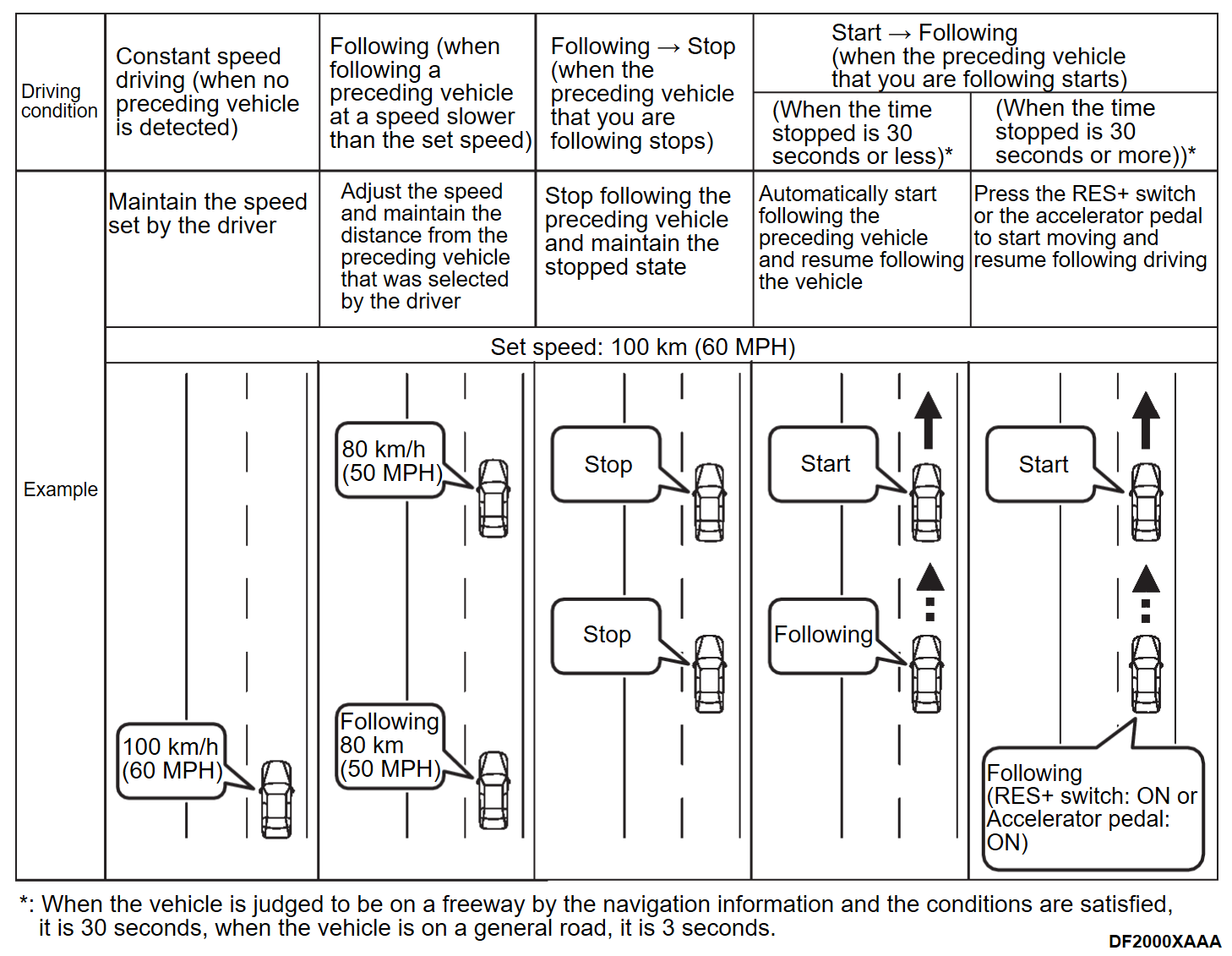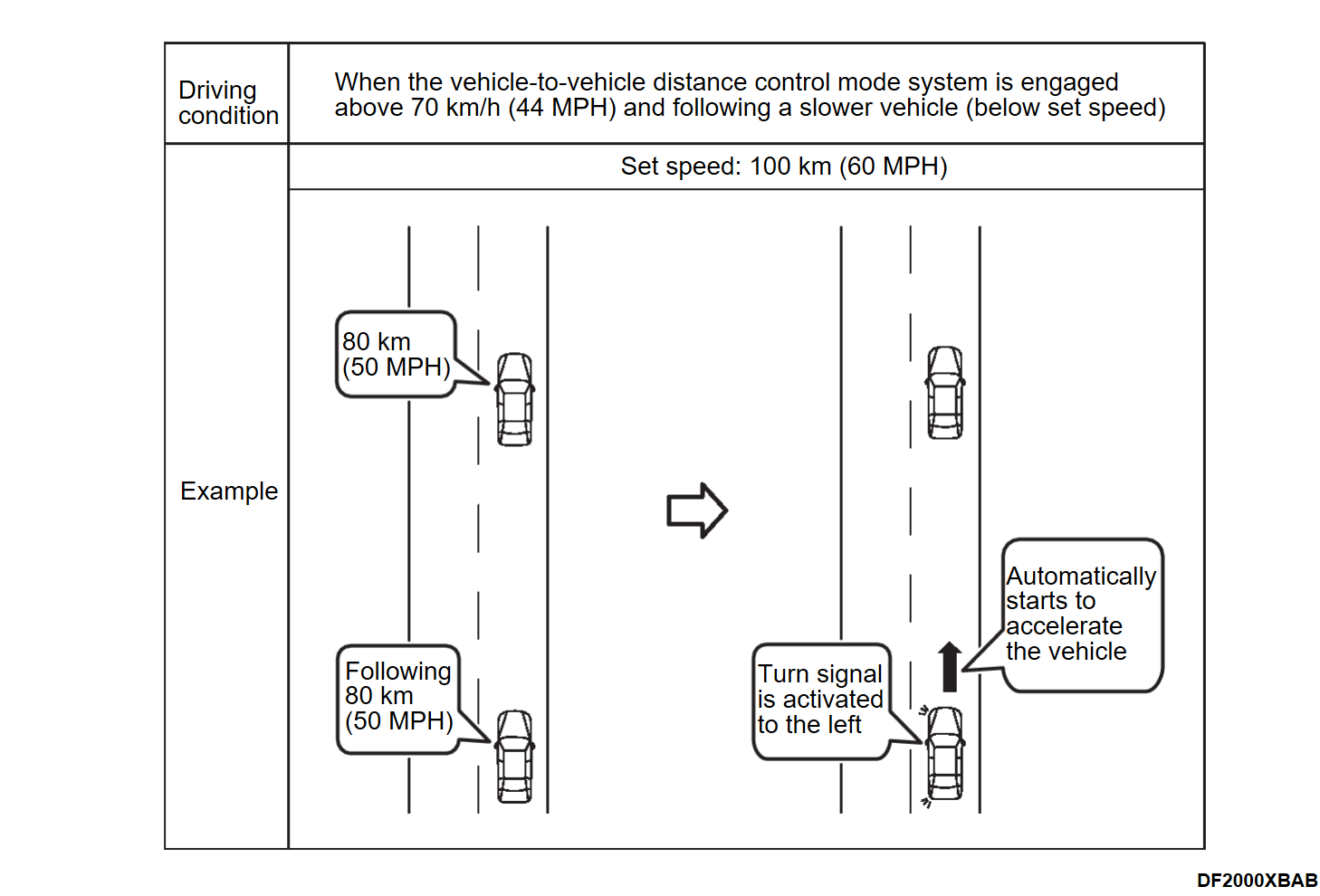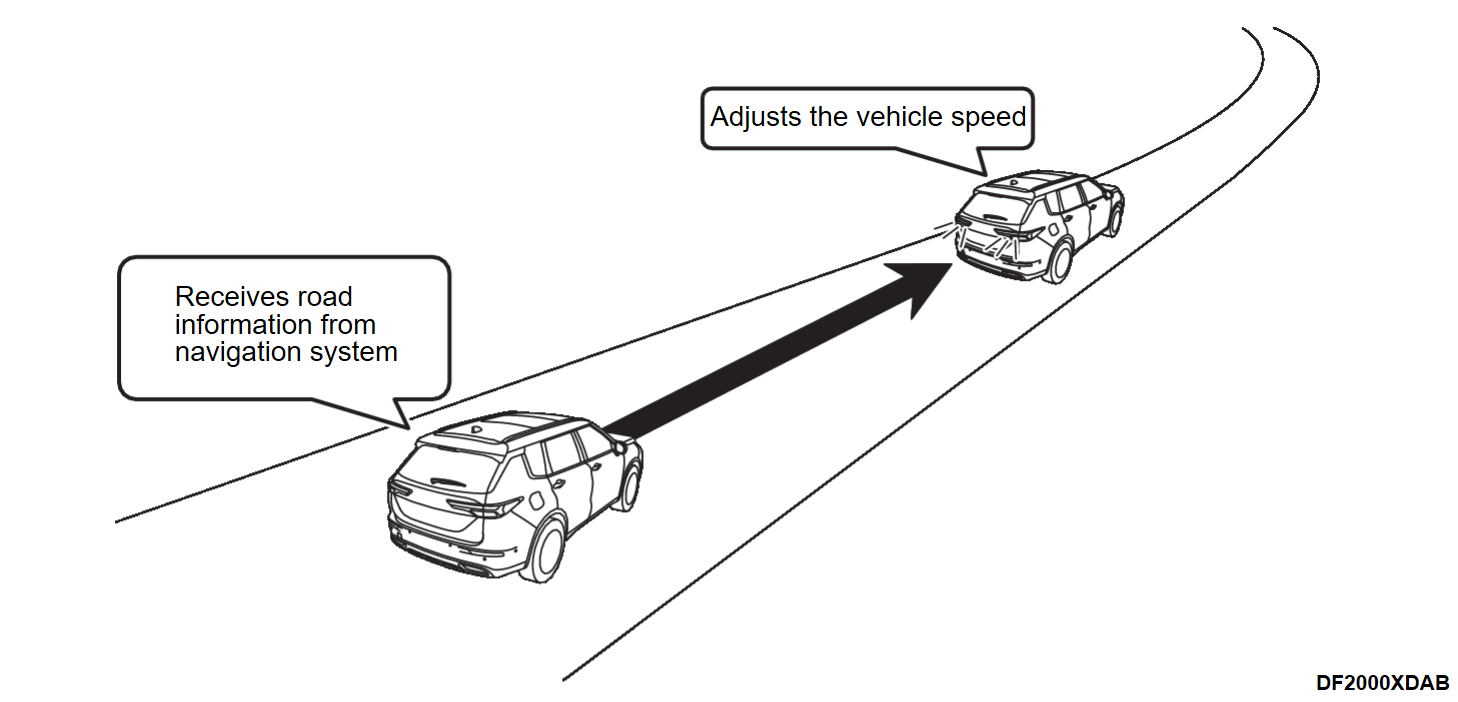System Description
FUNCTION DESCRIPTION
- The vehicle-to-vehicle distance control mode is designed to maintain a selected distance from the vehicle in front of own vehicle and can reduce the speed to match a slower vehicle ahead.
- The driver can select the distance from the vehicle ahead (Long/Middle/Short).
- If the status is the set wait condition and the vehicle speed is between approximately 30 and 144 km/h (20 and 90 MPH), when the SET‐ switch is pressed, the system records the vehicle speed and starts the control. If the vehicle speed is approximately 30 km/h (20 MPH) or less and a vehicle ahead is detected when the SET switch is pressed, a vehicle speed of 30 km/h (20 MPH) is set.
- The system decelerates the vehicle as necessary and if the vehicle ahead comes to a stop, the vehicle decelerates to a standstill. However, the system can only apply approximately 40% of the vehicle total brake force.
- The system cancels and a warning buzzer sounds if the speed is below approximately 25 km/h (15 MPH) and a vehicle is not detected ahead. The MI-PILOT Assist system is automatically canceled approximately 3 seconds after the vehicle is stopped, then the warning buzzer sounds.
- The vehicle-to-vehicle distance control mode operates as follows:
- When there are no vehicles traveling ahead, the system maintains the speed set by the driver. The set vehicle speed range is between approximately 30 and 144 km/h (20 and 90 MPH).
- When there is a vehicle traveling ahead, the system adjusts the speed to maintain the distance, selected by the driver, from the vehicle ahead. If the vehicle ahead comes to a stop, the vehicle decelerates to stop. The MI-PILOT Assist system is automatically canceled approximately 3 seconds after the vehicle is stopped, then the warning buzzer sounds.
- When own vehicle is stopped for less than 3 seconds (30 seconds for vehicles equipped with MI-PILOT Assist with Navi-link on a limited access roadway) and the vehicle aheadbegins to move, ownr vehicle starts moving again automatically.
- When own vehicle is at a standstill for more than 3 seconds (30 seconds for vehicles equipped with MI-PILOT Assist with Navi-link on a limited access roadway) and the vehicle aheadbegins to accelerate, push up the RES+ switch or lightly depress the accelerator pedal. The system starts to follow the vehicle ahead.
- When the vehicle traveling ahead moves to a different traveling lane, the system accelerates and maintains vehicle speed up to the set speed.
caution - This system should only be used when traffic conditions allow vehicle speeds to remain fairly constant or when vehicle speeds change gradually.
- If a vehicle moves into the traveling lane ahead or if a vehicle traveling ahead rapidly decelerates, the distance between vehicles may become closer because the system cannot decelerate the vehicle quickly enough. If this occurs, the system sounds a warning buzzer and blinks the system display to notify the driver to take necessary action.
- The vehicle-to-vehicle distance control mode does not control vehicle speed or warn the driver when the driver approaches stationary and slow moving vehicles. The driver must pay attention to vehicle operation to maintain proper distance from vehicles ahead when approaching toll gates or traffic congestion.
- The vehicle may not maintain the set speed on winding or hilly roads.
- To prevent the vehicle from moving, the driver must depress the brake pedal.
note - •When the accelerator pedal is depressed, the brake operation and the warning are not performed by the MI-PILOT Assist system.
- When the sonar system has a malfunction, the time the vehicle can remain stopped and automatically restart is shortened from 30 seconds to 3 seconds.
- The vehicle-to-vehicle distance control mode has the following functions:
Cut-in detection
If a vehicle enters the driving lane preceding your vehicle, the vehicle-to-vehicle distance control mode informs the driver by flashing the preceding vehicle detection indicator.
Approach warning
If own vehicle comes closer to the vehicle ahead due to rapid deceleration of that vehicle or if another vehicle cuts in, the system warns the driver with the buzzer and IM-PILOT system display.
| caution |
|
Acceleration when passing
- When the vehicle-to-vehicle distance control mode system is set above 70 km/h (44 MPH) and is following a slow vehicle (below the set speed), and then the left turn signal is turned on, the system will automatically start to accelerate the vehicle and begin to close the distance to the preceding vehicle in order to support passing on the right. Only the left side turn signal will operate this feature.
- As the driver steers the vehicle and moves into the passing lane, if no vehicle is detected ahead the system continues to accelerate to the set speed. If another vehicle is detected ahead,then the vehicle accelerates up to the following speed of that vehicle.
- If the vehicle is not steered into the left lane to pass, the acceleration stops after a short time and regains the set following distance.
- Acceleration can be stopped at any point by depressing the brake pedal or the CANCEL switch on the steering wheel.
Speed Limit Assist
- When MI-PILOT Assist is activated and a change in the speed limit is detected, a new speed limit indicator will be displayed and this can be applied to the vehicle’s set speed either automatically or manually.
- The Speed Limit Assist operates:
- When the detected speed limit sign is 30 km/h (20 MPH) and above.
- The “Speed Limit Assist” is enabled in the settings menu of the vehicle information display.
OPERATION DESCRIPTION
- When MI-PILOT Assist is OFF, pressing the MI-PILOT Assist steering wheel switch for less than 1.5 seconds displays the MI-PILOT Assist status, and the set wait condition is engaged.
- ADAS control unit 2 performs the control as per the following:
Driving at a constant speed The ADAS C/U 2 compares the set vehicle speed with the current vehicle speed and sends a command to the PHEV-ECU via CAN communication to reach the set vehicle speed and control the PHEV system. Following driving The ADAS C/U 2 sends commands to the PHEV-ECU, ABS actuator and electronic unit (control unit) to control the vehicle speed in order to maintain an appropriate distance between the vehicles in response to changes in the speed of the preceding vehicle. Following driving → Stop The ADAS C/U 2 sends commands to the ABS actuator and the electronic unit (control unit) to stop the vehicle. Once the vehicle stops, it is held at a stop. Start → Following driving When the ADAS C/U 2 judges that the RES+ switch has been pressed due to a MI-PILOT Assist steering switch signal from the PHEV-ECU or that the accelerator pedal has been pressed due to an accelerator pedal position signal from the PHEV-ECU, it sends a command to the PHEV-ECU to resume follow-up driving and to control the PHEV system. - When the ADAS control unit 2 judges that a vehicle moves into own traveling lane near own vehicle by the distance sensor signal from the distance sensor, it transmits the meter display signal to the combination meter to turn ON the vehicle ahead detection indicator.
- When the ADAS control unit 2 judges that own vehicle comes closer to the vehicle ahead due to rapid deceleration of that vehicle or another vehicle cuts in by the distance sensor signal from the distance sensor, it performs the following operations:
- Transmits the meter display signal to the combination meter to turn ON MI-PILOT Assist system display.
- Transmits the buzzer output signal to the combination meter to sound the buzzer.
- When the ADAS C/U 2 judges that the right turn signal is activated while the vehicle is following a slow vehicle (below the set speed) at 70 km/h (44 MPH) or more, it sends a command to the PHEV-ECU to accelerate the vehicle.
- If MI-PILOT Assist is activated and the ADAS C/U 2 determines that a new speed limit sign has been indicated, that will be applied to the vehicle’s set speed.
- When the ADAS control unit 2 receives the road information (curves, junctions and exits) from the navigation system, it transmits the command to the ECM to adjust the vehicle speed.
OPERATION CONDITION
- MI-PILOT Assist system: ON
- Vehicle speed: Between approximately 30 and 144 km/h (20 and 90 MPH)
CANCEL CONDITION
- When you press the CANCEL switch
- When you tap the brake pedal (except when stopped)
- When the system is turned off by pressing the main switch (the MI-PILOT Assist indicator will be turned off)
- When any door is open
- When the driver’s seat belt is not fastened
- When no preceding vehicle is detected and the vehicle speed is below 25 km/h (15 MPH).
- When the vehicle has been stopped by the MI-PILOT Assist system for approximately 3 minutes or longer
- When the shift lever is not in the “D” (drive) position
- When the electronic parking brake is applied
- When the ASC system is turned OFF
- When AEB is activated and strong braking is applied
- When ASC (including the traction control system) is operating
- When SNOW mode, GRAVEL mode or MUD mode is selected
- When a tire slips
- When the distance measurement becomes impaired due to dirt or obstructions adhering to the distance sensor
- When the radar signal is temporarily interrupted
![[Previous]](../../../buttons/fprev.png)
![[Next]](../../../buttons/fnext.png)


